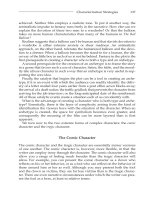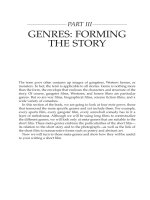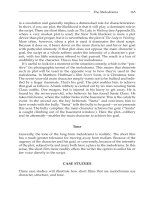Tài liệu Writing the short film 3th - Part 34 doc
Bạn đang xem bản rút gọn của tài liệu. Xem và tải ngay bản đầy đủ của tài liệu tại đây (117.55 KB, 7 trang )
PA RT I V
NEW DIRECTIONS
The short film is an apprentice story form in North America. In Europe it has
for many years been accepted as an art form. But technological and creative
changes, particularly over the last 10 years, suggest that we are on the cusp
of considerable change. The purpose of this section of the book is to pose
practical and speculative directions that change may take for the short film.
Ch17.qxd 9/27/04 6:12 PM Page 221
Ch17.qxd 9/27/04 6:12 PM Page 222
17
THE OPPORTUNITY
FOR RENEWAL
Who would have thought that Martin Scorsese and Spike Lee, who began
their careers as student filmmakers, would return to the short film mid-
career? BMW hired each filmmaker to make a short film about his car that
would be shown on its website. The films have been so successful that at
least one has been released in select cinemas and the series is available for
purchase on DVD. Scorsese had returned earlier to the short form to make
the Michael Jackson music video “Bad” for the album ‘Thriller. Spike Lee, on
an ongoing basis, makes commercials. Thus, short films continue to be an
important ongoing element of the creative careers of both Martin Scorsese
and Spike Lee.
They are not alone in this movement between the feature film and the
short film. A significant change has been brought about by advertisers,
whether for products such as cars or music. They have redefined and broad-
ened the kind of work they sponsor under the umbrella of advertising. In the
same way, the nonlinear film in its forms and its approach to character and
structure has stretched what is considered the entertainment or commercial
feature film. In short, change is occurring in every form, from the commer-
cial to the feature film. If we add the technological shift from film to digital
video, we add yet another layer of change.
The question that all this raises for us is this: What changes are viable for
the short film, a form that, to date, has been most closely aligned with the
short story and the poem?
For the most part, filmmakers, like most people, resist change. Traditional
genres and approaches to character, structure, and voice affirm the order of
things, i.e., tradition. This is how one imagines choices in a stable, traditional
world. But what is one to make of a rapidly changing world, where the
growth industry is the change agent—that category of consultant whose
223
Ch17.qxd 9/27/04 6:12 PM Page 223
main purpose is to help the rest of us manage change? This is the state of
things today. Change is everywhere—in globalization and its corollary, inter-
dependence; in the economy; and in personal psychology. The gatekeepers
of society, the religious establishment and the political establishment, have
rarely faced greater challenges. And the media and the purveyors of goods
within the media—the journalists, the videographers, and the filmmakers,
are dizzy with the opportunities changes afford them.
In filmmaking particularly, the outcome has been a pronounced search
for novelty. In fact, I don’t think it’s an overstatement to characterize that
search as a mania for novelty. To connect with the audience, filmmakers
seek out a new slant on an old story, an unusual form, or an exaggerated
voice in the telling of the tale. Whatever the strategy, novelty is the goal.
Without the surprise novelty promises, the fear is that the audience will
drift away. Today, feature filmmakers and short filmmakers share a fixa-
tion on novelty to engage and sustain their relationship with the audience.
This search for novelty affirms the pressure of ongoing changes within
our society.
In keeping with a time of change, filmmakers feel they need to reinvent
themselves. Turning to the filmmakers I mentioned earlier, Martin Scorsese
and Spike Lee, each has established a creative portfolio, principally of fea-
ture films. In addition, each has made commercials and MTV videos. But the
principle of reinvention has gone even further. Martin Scorcese has rein-
vented himself as a filmmaker/scholar. He has created four 8-hour docu-
mentaries devoted first to American film and more recently to Italian
cinema. Spike Lee, on the other hand, has looked to the documentary film to
reinvent and reinvigorate himself. First with his documentary, Four Little
Girls, and more recently with Get on the Bus, Spike Lee has turned to critical
moments in African-American history to expand upon his creative man-
date—to be as much an educator as an entertainer in his films.
Other filmmakers shift genres for renewal, still others shift roles—to that
of producer, in the case of Jonathan Demme—all in pursuit of the notion of
reinvention. No group has sought reinvention more vigorously than actors,
a number of whom have successfully turned to directing.
At the same time as filmmakers seek out novelty and reinvent themselves,
the lines of separation between different media, as well as different forms—
advertising and the feature film, for example—are blurring. At the industrial
organization level, film studios are owned by a holding company that
embraces television station ownership, publishing, music recording and in
one case, electronics; in another, satellite cable stations; and in another, water
utilities. This no doubt will shift over time, but in principle, it means that film
production, television production, theater production, music production, and
book production are in numerous cases owned by the same corporate struc-
ture. One can imagine the synergistic as well as monopolistic possibilities.
224 Writing the Short Film
Ch17.qxd 9/27/04 6:12 PM Page 224
On another level, however, the changes are more subtle, more migratory, and
more interactive. Stage productions have long been influenced by film produc-
tions, but today it is not uncommon to see highly theatrical films as often as
highly filmic theatrical productions. In television, the hour-long series has often
been presented as an unresolved story—in short, a serial. From Dallas to ER to
West Wing, the macro-storyline—as well as the story of the week, the micro-
story—has altered the look and story shape of the hour-long TV film. More
recently, the 30-and 60-second commercial have begun to take on the shape of
the serial or ongoing story. Consequently, more character and an incomplete
dramatic arc are increasingly forming the shape of the commercial. How many
feature films have you seen that look increasingly like an episode (Spiderman,
The Mummy)? What we are suggesting is that the shape of the B-movie serial
has drifted into television, the commercial, and the feature film.
Following this principle, the music video has influenced commercials and
the feature film. The commercial has influenced the action-adventure film,
and the TV situation comedy has become a standard in the feature film, both
in the action-adventure genre and in the romantic comedy feature film. Even
the police story has dipped into the TV sitcom genre. My point here is to note
the transmigration of form across genres, across distribution systems. Media
presentations have morphed and blurred the lines between media presenta-
tion and distribution systems. A lot has changed. This has enormous impli-
cations for the short film.
Today, digital video, digital sound, the computer, and the availability of
high-level delivery systems have democratized the means of production—
the camera, the microphone, the editing system (a computer)—‘it’s all digi-
tal information. And it ‘doesn’t require high-level skills or knowledge to
operate. The implications of this situation for the short film are simply stag-
gering. Anything is possible. You have only to do it.
Of course, this situation has implications for education, or to put it another
way, the knowledge industry. The acquisition of knowledge should be and
can be shorter in the time it takes and less expensive in cost. This book is part
of that knowledge industry, as are the classes the writers of this book teach.
So the technology has changed, the industry structure has changed, rein-
vention is in the air, and novelty may be our goal. All of the above invites—
no, demands—that the maker of short films embraces change and explores
the forms that will make his or her short film new and novel to the rest of us.
THE CURRENT SITUATION
In North America, the short film continues to be an apprenticeship form.
This means that it is predominantly viewed as a portfolio piece. Although
festivals, cable television sales, and increasingly commercially sponsored
The Opportunity for Renewal 225
Ch17.qxd 9/27/04 6:12 PM Page 225









